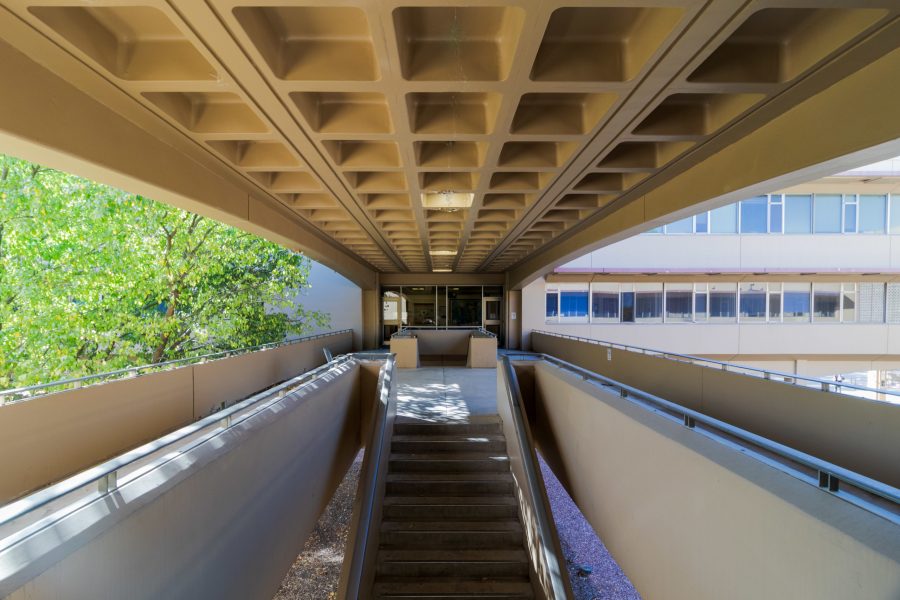Located along the Center Avenue Mall and spanning 252,000 square feet on nearly 4 acres, the Andrew G. Clark building looms, awaiting renovations that are just around the corner. As the home of the College of Liberal Arts for the last 55 years, Clark has had a key role in shaping certain programs and Colorado State University students in both the past and present.
Nearly everyone has had a class within the historic walls of Clark, and most would agree Clark’s main issues are the infrastructure, the peeling paint and the leaking ceilings; however, you have to wonder what was it like before it began crumbling over time.
Formerly known as the Social Science Building, Clark has been the center for the liberal arts since it was built in the late 1960s. At the time, it was an architectural masterpiece, which is a far cry from the current reputation it has on campus.
When the construction of the entirety of Clark wrapped up in the fall of 1968, the building was a central point on campus, much like it is today. It was designed by the architect James M. Hunter, a Boulder-based architect who practiced from 1936-73 and styled the building after new formalism, a type of modern architectural style that mixed traditional structures with more modern ideals.
“Beginning right before World War II, but especially after World War II, there is a spectacular growth in minimal modernism,” said Adam Thomas, history department associate teaching professor. “Just glass boxes, concrete and steel. Some architects felt that it was a betrayal of the classical roots of architecture. So they tried to marry the two by creating this very minimalist version of classical architecture, which they called new formalism.”
From the brise soleil — the infamous wine rack covered in chicken wire — to the columns that hold up Clark B, Clark is a perfect example of new formalism. Even still, Hunter had one more goal in mind, and that was for Clark to be a place of community and comradery.
“What was really important to Hunter was that his buildings portrayed a sense of community and culture,” said Sarah Payne, associate professor in the history department at CSU. “I think you can see that in the Clark Building, even though our definition today of community and culture is definitely different than what he envisioned in the 1960s.”
Clark continues to be a central hub for those majoring in the liberal arts, hosting a variety of classes and departments including language arts, history, political science and journalism. A study by the College of Liberal Arts shows 99% of students have a class within the building at some point. Clark was designed to be a workhorse for the campus — a place where ideas and connections are shared. It continues this purpose today despite its state of disrepair.
“One of the things James Hunter talked about whenever he designed the Clark building was this idea of the liberal arts in the center of enlightenment and that as you walk down the hall through these departments, you would hear all these various conversations going on,” Thomas said.
“I have advised nearly a hundred graduate students in history now, and I just have such great memories of conversations I’ve had with them. You know the look on people’s faces when something clicks for the first time, where they get excited about an idea? So many ideas have been born and just exploded in this building.” -Sarah Payne, associate history professor
Unfortunately, the goal Hunter had in mind for the community and the connections that Clark would bring have fallen short in the ways he intended. Its construction and architecture make creating these connections more complex, as having odd little spaces and benches around the entirety of the building makes it difficult to gather.
“Someone once described people’s perceptions of Clark as transactional,” said Robert Gudmestad, professor and chair of the history department. “In other words, you come here for a class, and then you leave, and you don’t really stay and hang out necessarily because there aren’t a lot of really comfortable spaces.”
Despite the main purpose of the building’s construction not meeting expectations with the influx of students, it has not completely stopped the connections or flow of ideas. Clark is the host of many minds and has continued to allow for ideas to spring up and for connections to be built despite the odd construction.
“I have advised nearly a hundred graduate students in history now, and I just have such great memories of conversations I’ve had with them,” Payne said. “You know the look on people’s faces when something clicks for the first time, where they get excited about an idea? So many ideas have been born and just exploded in this building.”
With renovations set to start later this year, it’s important to remember that Clark used to be a point of pride and community for the campus and in some ways still is. Its original purpose has not been entirely lost as is evident by the continuously growing connections people make around the building every day.
“We have just created strong, powerful programs because, in the end, it’s the people that matter, not the building,” Thomas said.
Reach AJ Sanchez at news@collegian.com or on Twitter @csucollegian.






